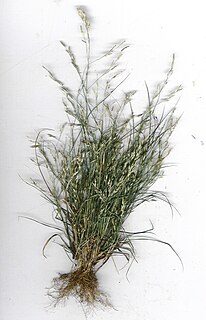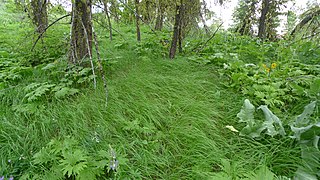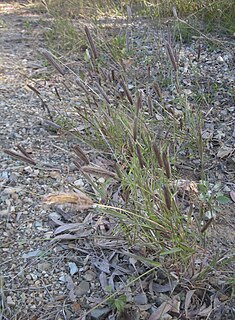
Nassella, or needlegrass, is a New World genus of over 100 perennial bunchgrasses found from North America through South America. The Latin word nassa refers to "a basket with a narrow neck". It is usually considered segregate from the genus Stipa and includes many New World species formerly classified in that genus. As of 2011, The Jepson Manual includes Nassella within Stipa.

Danthonia californica is a species of grass known by the common name California oatgrass. This plant is native to two separate regions of the Americas, western North America from California to Saskatchewan, and Chile.

Danthonia intermedia is a species of grass known by the common names timber oatgrass, intermediate oatgrass, and mountain wild-oat grass. This clumping erect perennial grass is native to North America, where it is widespread across most of Canada and along the western United States into California. It is a plant of the plains as well as forested, mountainous, alpine environments.

Enneapogon desvauxii is a species of grass known by the common name nineawn pappusgrass. This is a short perennial bunchgrass native to the southwestern United States, northern Mexico, parts of South America, and occurs throughout arid parts of Africa. It is known less often on other continents.

Eragrostis cilianensis is a species of grass known by several common names, including stinkgrass, candy grass, and gray lovegrass.

Eragrostis pectinacea is a species of grass known by the common name tufted lovegrass. This plant is native to the Americas from Canada to Argentina. It is widespread, growing in most open spaces at varying elevations and habitats, including in disturbed areas and roadsides.

Glyceria leptostachya is a species of mannagrass known by the common names davy mannagrass and narrow mannagrass.

Hierochloe occidentalis is a species of grass known by the common name California sweetgrass. It is a close relative of the more widely known sweet grass. It is native to the west coast of the United States from Washington to California, where it grows in the coniferous forests of the coastal mountain ranges. This is a rhizomatous perennial grass with leaves up to 30 centimeters long and 1.5 wide. The stem reaches a meter in height with an inflorescence of 7 to 10 centimeters. The spikelets grow on short, wavy stalks and each has three florets with long, protruding stamens during flowering.

Bromus madritensis is a species of brome grass known by the common name compact brome. The specific epithet madritensis refers to Madrid, Spain. It has a diploid number of 28.

Bromus catharticus is a species of brome grass known by the common names rescuegrass, grazing brome, prairie grass, and Schrader's bromegrass. The specific epithet catharticus is Latin, meaning cathartic. The common name rescuegrass refers to the ability of the grass to provide forage after harsh droughts or severe winters. The grass has a diploid number of 42.

Calamagrostis bolanderi is a species of grass known by the common name Bolander's reedgrass. It is endemic to northern California, where it grows in moist coastal habitat such as temperate coniferous forest, wet meadows and bogs, and coastal scrub.

Calamagrostis rubescens is a species of grass known by the common name pinegrass.

Chloris gayana is a species of grass known by the common name Rhodes grass. It is native to Africa but it can be found throughout the tropical and subtropical world as a naturalized species.

Chloris virgata is a species of grass known by the common names feather fingergrassfeathery Rhodes-grass and feather windmillgrass.

Poa compressa, the Canada bluegrass or flattened meadow-grass, is a perennial flattened meadow grass, similar to common meadow-grass, Poa pratensis. It is native to Europe but it can be found nearly worldwide as an introduced species. It grows in old wall tops, pavement cracks, dry stony grassland, and many types of wild habitat. It has a flattened stem, 23–30 cm tall, a close one sided panicle of grey green, with purple florets.

Orcuttia is a genus of grass in the family Poaceae. Plants grow up to 20 cm (8 in) tall, usually with many stems emerging from the base of the plant, and forming a tuft. The spikelets are several-flowered, with reduced upper florets. The lemma tips have between two and five teeth.
Torreyochloa erecta is a species of grass known by the common name spiked false mannagrass. It is native to the Cascade Range and Sierra Nevada ranges, its distribution extending from California north into Oregon and east into Nevada. It grows in mountain forests and the margins of lakes and streams, at elevations above 2000 meters. It is a rhizomatous perennial grass producing thick, erect stems up to about 60 centimeters in maximum height. The inflorescence is a narrow panicle much longer than wide, containing wide, compressed spikelets containing 4 to 6 florets each.

Torreyochloa pallida is a species of grass known by the common names pale false mannagrass and weak manna grass. It is native to North America, especially the east and west sides. It grows in wet habitat, such as rivers, lakesides, bogs, and swamps. It is a rhizomatous perennial grass producing thick, erect to decumbent, sometimes matted stems which can easily exceed one meter in maximum length. The inflorescence is a branching panicle up to 25 centimeters long by 12 wide containing compressed spikelets with up to 8 florets each.
Tridens muticus is a species of grass known by the common name slim tridens. It is native to Mexico and the southwestern quadrant of the United States, where it grows several types of habitat, including plateau and desert, woodlands, sagebrush, plains, and other areas with dry sandy and clay soils.

Deinandra conjugens is a rare species of flowering plant in the aster family known by the common names Otay tarplant and Otay tarweed. It is native to a small section of far northern Baja California in Mexico, its range extending north into San Diego County, California, in the United States. One isolated population has been reported from the hills east of Cayucos in San Luis Obispo County.


















